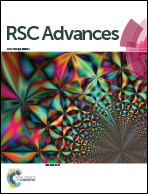Three-dimensional superhydrophobic porous hybrid monoliths for effective removal of oil droplets from the surface of water†
Abstract
An effective, facile approach is reported for constructing three-dimensional (3D) superhydrophobic porous hybrid monoliths by a reduced self-assembly procedure using a graphene oxide (GO) and polystyrene (PS) solution with L-ascorbic acid. Water contact angle (CA) measurements demonstrate that the entire body of the reduced graphene oxide/PS (rGO/PS) monolith is superhydrophobic, with a water CA of 156° for the surface and 152° for the cross-section. A nitrogen adsorption–desorption analysis reveals that there are a large number of pores (153.9 m2 g−1, BET) in the monoliths. The superhydrophobic porous hybrid monoliths exhibit a remarkable capability to adsorb a wide range of organic solvents and oil droplets from the surface of water. Furthermore, the highly water repellent character of the monoliths is still kept even under severe conditions (e.g. acidic, basic and saline). Such expedient and low-cost superhydrophobic porous monoliths have a lot of promising potential applications, including self-cleaning, anti-corrosion, anti-sticking, water remediation and oil spillage cleanup.


 Please wait while we load your content...
Please wait while we load your content...